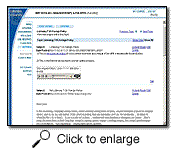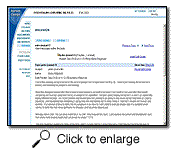Using a Discussion Board
A discussion board is a communication tool used to share messages, which can be questions or responses, comments, or announcements that are accessible to the members of a group.
An electronic discussion board is a group communication tool that allows for the public sharing of messages. A message (commonly called a "post") can vary in content -- it can be a question or response, a comment, or an announcement that a member wants to circulate among the group. A message that inaugurates a conversation is called a topic. A series of messages in response to a topic is called a thread.
A discussion board can be hierarchically divided into categories and forums; this offers an efficient way to organize discussions in support of major topics or areas of interest. Discussion boards are "asynchronous" in nature, meaning that the participants do not participate simultaneously. Most discussion boards support messages containing images, web links, and media file attachments.
The primary benefit of a discussion board is that content posted to the board can be accessed at any time. Students can choose to reply upon reading a comment, or they can return to the board at a later time after mulling over a response. As in a real discussion, students can simply listen without necessarily contributing. Moreover, discussion boards offer a useful way to explore the topology of a conversation; visual cues like hierarchical indentation can help an instructor track shifts in the content of a discussion and open up further lines of inquiry while also letting the conversation's initial thrust continue uninterrupted.
Though discussion boards might be considered impersonal by some, they can enhance class discussions in a number of ways:
- They can provide a more level playing field for shy or ESL (English as a Second Language) students, providing them with a venue in which they can more comfortably articulate their ideas.
- The instructor can provide preparatory materials for outside-of-class work, thereby optimizing discussion time in the classroom.
- They can maintain a sense of continuity (and community) between class sessions by allowing for discussion and reflection beyond scheduled class time.
- Students can engage in critical debates, requiring a deeper level of participation than simply listening to a lecture. The textually-based nature of the discussion board also makes it easier for students to offer evidence of sustained engagement with class material.
- They provide an outlet for all class-members to pose questions and receive feedback, not just from the instructor, but also from peers.
- They allow students to share information or references with each other.
- They represent an archive of discussions useful for later review.
- Discussion boards' archives can also be used as a review tool.
The following chart illustrates how discussion boards compare to other communication and collaboration tools:

What is my role as the instructor when using a discussion board?
- State the purpose of the discussion board.
- Define the level of participation required by students and how that participation will be evaluated. Some instructors require each student to post an open-ended question based on course readings by a predetermined date, in order to encourage use of the discussion board.
- Use the syllabus to provide information on discussion board use.
- Declare limits on length of postings (sometimes less is more).
- Declare the level of participation students should expect from you. Define categories with varied purposes and parameters so your participation can choose where to post among the different boards.
- Advise teaching assistants of their responsibilities pertaining to the discussion board.
- Refer to discussion board posts in class discussion.
What are the types of discussion boards to consider for my class?
A discussion board can be used in many ways. Using the category or forum feature allows the instructor to create different kinds of uses within a course discussion board. Here are some examples:
- A Noticeboard: a place for class announcements
- FAQ (frequently asked questions): answers to the questions that students repeatedly ask about your course, your research, or department
- General queries: a forum for general queries about the course
- Course discussion: a forum for topics seeded, moderated, or monitored by the instructor.
- Assignment discussion: a place for students to ask questions about problems or challenges they've encountered in an assignment.
A Few "Tips"
- Very large classes can be broken into smaller, more manageable groups. The same topics can be used for each group, or varied topics can be used if you'd like to spur different conversations. Breaking a large class into subsets can help make online conversations more manageable for students, as well as diversify contributions to the class as a whole. However, it can also dramatically increase the workload for the instructor.
- Discussion topics are normally inserted into a discussion board in chronological order. Therefore, if you intend to use "noticeboards" or "FAQ boards" in your teaching and, if you want them to be prominent, set them up early in the semester (before any other boards or categories are established).
Examples of Discussion Boards
English for International and Public Affairs: INAF U6950
Columbia Professor Leila May-Landy
 In this School for International and Public Affairs course, international graduate students focus on English language communication skills. Specifically, students focus on improving their speaking skills by delivering weekly in-class oral presentations.
In this School for International and Public Affairs course, international graduate students focus on English language communication skills. Specifically, students focus on improving their speaking skills by delivering weekly in-class oral presentations.
As a means of extending her students' ability to evaluate their own performances, Leila May-Landy uses the Discussion section of CourseWorks, Columbia University's course management system, in conjunction with ThirdSpace (a discussion board-based tool that can excerpt segments of video and/or audio directly into postings) to create online "portfolios" in which she and her students present and analyze samples of oral presentations. Using CourseWorks and ThirdSpace in this manner provides her and her students with a flexible workspace in which to communicate and extend many of their other in-class activities. For students and teacher alike, some of the most notable benefits of this solution are:
- The instructor can create and distribute feedback in both written and oral form so that students can not only read about their mistakes, but also hear corrections.
- Students have the ability to watch their own and their peers' oral presentations as often as they like so they can discover speaking mistakes that they might otherwise miss.
- ThirdSpace, unlike a traditional VCR setup, allows students, as well as Leila May-Landy to "index" important sections of a video of an oral presentation so that the relevant sections can be easily accessed when the presentation is being analyzed or critiqued.
As a result, her use of CourseWorks extends and enhances many common ESL instructional methods in ways that could not otherwise be accomplished in a traditional classroom-based learning environment. Course evaluations show that using CourseWorks in this manner contributes to students' increased confidence and ability to speak English correctly.
Exploring the Poles: FYSB X1566.001
Columbia Professors Stephanie Pfirman and Robin Bell
 This course challenges non-science majors to learn the science skills necessary for undertaking a polar expedition, to read and discuss the accounts of past polar explorers, and to produce personal journals based on their own simulated polar expedition. The main obstacles students face in completing these requirements are their lack of background knowledge and terminology for thinking, arguing, and writing meaningfully in a scientific context. Stephanie Pfirman and Robin Bell's solution is to use the Discussion section to create a space in which students write their personal journals and instructors provide timely, informative, and confidential feedback on each student's weekly writings.
This course challenges non-science majors to learn the science skills necessary for undertaking a polar expedition, to read and discuss the accounts of past polar explorers, and to produce personal journals based on their own simulated polar expedition. The main obstacles students face in completing these requirements are their lack of background knowledge and terminology for thinking, arguing, and writing meaningfully in a scientific context. Stephanie Pfirman and Robin Bell's solution is to use the Discussion section to create a space in which students write their personal journals and instructors provide timely, informative, and confidential feedback on each student's weekly writings.
By providing feedback in this manner, Stephanie Pfirman and Robin Bell are better able to quickly catch and correct students' mistakes in scientific writing, with the goal of improving future journal entries. Additionally, by using CourseWorks, they construct a comprehensive learning environment where students can access the course's specially designed polar expedition site simulation, engage in online collaborative writing, view the course syllabus, access various class notes, and receive assignments. Pfirman and Bell have constructed an extension to their class that helps students to engage in aspects of scientific thinking, writing, and hypothesis formulation, which might otherwise be a difficult task in a classroom-only setting.
How to Get Started
Every class at Columbia automatically gets a CourseWorks site, which includes a discussion board. Visit the Center for New Media Teaching and Learning's website to download the CourseWorks Discussion Board Documentation: https://ccnmtl.columbia.edu/services/courseworks/documentation/CWDiscussions.pdf
Additionally, all Wikispaces sites (http://wikispaces.columbia.edu) allow for discussion boards to be set up on each page. More information can be found in Wikispaces' help.


